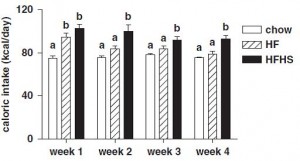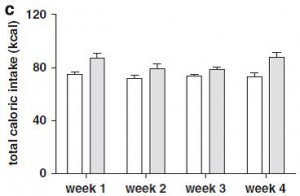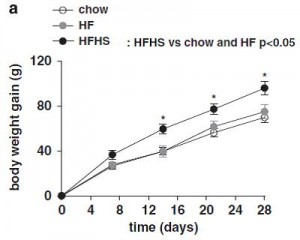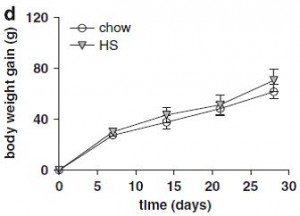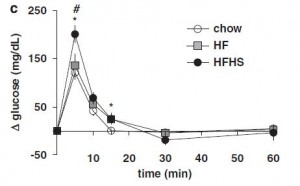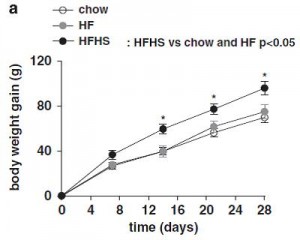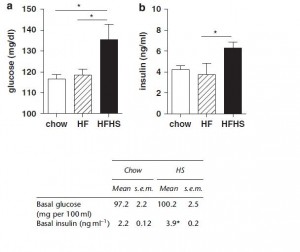This can be considered as somewhat of a follow-up to the previous post about the deleterious effect of the high fructose high fat diet in rats. As a brief refresher, rats fed high fat were far healthier than those fed high fat and high fructose. IOW, sugar makes everything bad happen. In the current study, researchers first tested a high fat diet vs. a high fat high sugar diet, got interesting results, and asked the obvious follow-up question: what about high sugar alone?
A free-choice high-fat high-sugar diet induces glucose intolerance and insulin unresponsiveness to a glucose load not explained by obesity. (La Fleur et al., 2011 International Journal of Obesity)
The diets were odd, as is such when including “free-choice.” All rats received standard chow; those in a high-fat group (HF) were given a dish of beef tallow, which is high in saturated fat, while those in a high-sugar group were given a bottle of 30% sucrose (table sugar), which is composed of glucose and fructose in a 1:1 ratio (similar to high-fructose corn syrup). Rats in the high-fat high-sugar (HFHS) group received both.
Fortunately, the researchers measured food intake with meticulous detail, so we know exactly how much sugar, fat, and calories were ingested.
For starters, when given the option of a high-fat high-sugar food, rats [and people] eat more:
As seen above (for HF) and below (for HS, closed bars), this is not the case when either are fed alone:
The increased calorie intake exhibited by the rats fed HF during week 1 was probably due to the increased caloric density of the food. As soon as their brain detected the increased calorie influx, less food was ingested leading to a normalization of calorie intake. This is not the case when sugar is added to the fat; considering eating butter (high fat) or icing (high fat high sugar). Of which would you eat more?
Body weight followed a similar pattern, which HFHS gaining more weight than any other group.
Unfortunately these researchers measured fat mass by excising and weighing the individual adipose depots. This method is inferior to most other techniques and is very inaccurate but very cheap. So we will never know precisely how body composition was affected by these interventions.
Basal glucose and insulin were elevated in HFHS, but not HF. Basal insulin was elevated in HS. IOW, high fat alone did not alter body weight, basal insulin, or basal glucose, while high sugar caused an increase in basal insulin. Thus, while HFHS is the real bad guy, HS is almost as bad.
This is roughly similar to what was we saw previously. In accord with the body weight results, and as is usually the case, glycemic response to an intravenous glucose load was most impaired in HFHS:
Did this study bring anything new to the surface? You be the judge. I’m still trying to figure out why the title of the paper stated that these effects were “not explained by obesity.” In their conclusion, the authors stated that rats fed HF and HFHS became obese, but that’s not true:
HFHS became obese, while HF remained at the same body weight as control. The authors tried to stretch it to 1) exonerate (or not fully condemn) HS, and 2) put HF in the same ballpark as HFHS. Things look differently when the conclusions are viewed with the data posted right next to them. According to their data, rats on the HF diet looked similar to controls while those on HS had elevated fasting insulin:
Furthermore, and I hate to have to butcher graphs like this, but if you directly compare the results shown in Tables 1 and 2, it is clear that rats fed the HS diet exhibited significant metabolic derangements, similar to HFHS, while HF stayed relatively healthy.
Note the results from the first experiment for glucose AUC: chow (1010), HF (872), and HFHS (1505), compared to the results from the second experiment for glucose AUC: chow (1153), and HS (1447). In the first experiment, HFHS was much worse than chow; in the second experiment, HS was as worse than chow as HFHS was in the first experiment.
Also, basal glucose was lower in HF compared to controls (117.2 vs. 121.0), while it was higher in HS compared to controls (95.2 vs. 90.7).
Actually, these data (not the interpretation) are in close agreement with those from that previous post:
High fat high sugar (closed circles), sugar free high fat (open circles), and high fat high sugar switched to sugar free high fat (open squares).
So I’m not really sure why the authors interpreted these data to mean that HF was worse than HS and almost bad as HFHS. This is categorically untrue. A case of lipophobia? Or perhaps it’s what you get when a bunch of neuroscientists try to conduct [and interpret!] a study about nutrition. This study was done at the Rudolf Magnus Institute of Neuroscience in the Netherlands.
Calories proper

